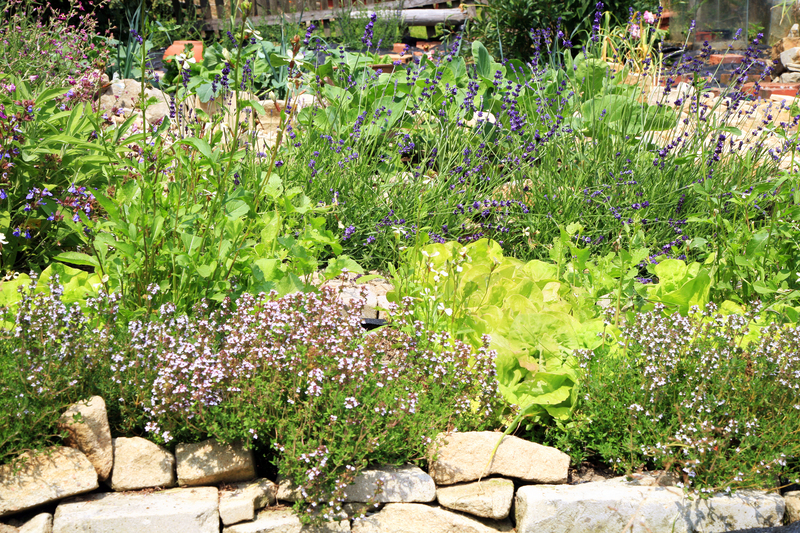Wind-Resilient Gardening: Techniques for Success
Posted on 26/08/2025
Wind-Resilient Gardening: Techniques for Success
Are gusty winds wreaking havoc on your garden? Developing a wind-resilient garden not only protects your plants, but also ensures that your outdoor haven thrives in even the most challenging environments. Whether your garden is perched seaside, nestled on a hilltop, or you simply face occasional blustery conditions, mastering the art of windproof gardening is essential to cultivating a lush and flourishing space.

Understanding Wind Damage in Gardens
Before diving into wind-resistant gardening techniques, let's first examine how strong winds affect your garden:
- Physical Damage: Persistent or strong winds can snap stems, break branches, and physically uproot entire plants.
- Desiccation: Wind accelerates water loss from both soil and plant leaves, causing wilting, dehydration, and leaf scorch.
- Pollination Interference: High winds can disrupt pollinators and hinder the successful transfer of pollen, especially in fruit and vegetable gardens.
- Soil Erosion: The force of wind strips away topsoil, exposing plant roots and depleting the soil's nutrient content.
Key Principles of Wind-Resilient Gardening
Creating a wind-resistant garden involves a combination of thoughtful design, plant selection, and strategic gardening techniques. Below are the core principles to help your garden stand strong against the wind:
- Buffer creation: Use windbreaks and barriers to shield your garden.
- Smart plant selection: Opt for wind-tolerant species and cultivars.
- Soil management: Maintain healthy, well-structured soil to reduce erosion and support root growth.
- Garden layout: Arrange plants and structures to minimize wind's impact.
- Proper support: Stake and tie fragile or tall plants for extra stability.
Designing Wind-Resilient Gardens: The Power of Windbreaks
What Are Windbreaks?
Windbreaks are physical features--natural or artificial--designed to slow and redirect the wind, reducing its velocity before it hits your valuable plants. They are fundamental to any windproof gardening strategy.
Types of Windbreaks
- Living Windbreaks:
-
Artificial Windbreaks:
- Fences (preferably slatted or louvered rather than solid for better wind diffusion)
- Garden netting or windbreak fabric
Pro tip: A windbreak that blocks 50-60% of the wind is more effective and less turbulent than a solid wall that blocks 100%.
Selecting and Placing Windbreaks
- Strategic placement: Establish windbreaks on the side from which prevailing winds blow (often the west or northwest).
- Gradual transition: Use a combination of tall and medium-sized plants for a tiered windbreak. This helps gradually diffuse the wind instead of creating turbulence on the leeward side.
- Spacing: Plant trees and shrubs far enough apart (about 1-2 times their mature width) to allow wind to pass through and prevent root competition.
- Maintenance: Prune windbreaks regularly to maintain density and health.
Choosing Wind-Tolerant Plants
The success of a wind-resilient garden hinges on your choice of wind-resistant plants. Some species naturally withstand strong winds due to their flexible stems, deep roots, or tough foliage.
Features of Wind-Resistant Plants
- Flexible branches and stems that bend rather than break
- Small, narrow, or thick leaves that lose less moisture and are less likely to tear
- Deep or fibrous root systems that anchor plants in windy weather
Top Plant Choices for Windy Gardens
- Grasses: Switchgrass (Panicum virgatum), Fountain Grass (Pennisetum alopecuroides)
- Perennials: Yarrow, Sedums, Russian Sage (Perovskia atriplicifolia)
- Shrubs: Rugosa Rose, Oleander, Tamarisk, Escallonia
- Trees: Hawthorn, Birch, Willow, Pine, Cypress
- Coastal plants: Sea Holly, Santolina, Hebe
Native plants are usually more adapted to your area's unique wind and climate challenges, making them an excellent choice for wind-resistant landscaping.
Garden Layout and Microclimates
The arrangement of your plants and features plays a crucial role in minimizing the effect of wind. Here are expert tips for optimizing your garden's layout:
Create Microclimates
- Group susceptible plants together in sheltered spots, using windbreaks or structures as protection.
- Use buildings, fences, or existing trees as part of your windbreak strategy, combining them with additional plantings as needed.
Stagger Planting Rows
- Instead of straight rows, plant in staggered or diagonal patterns to slow the wind and minimize direct exposure.
- Position tall, wind-hardy plants as outer rows, with delicate or vulnerable varieties inside.
Consider Raised Beds and Containers
- Using raised beds can help anchor root systems and reduce the effect of soil erosion.
- Containers can be clustered for protection, but may need frequent watering due to faster drying from wind.
Soil Management for Wind-Resilient Gardens
Healthy, well-structured soil is your garden's first defense against wind-related damage. Here's how to manage your soil for wind resistance:
Preventing Soil Erosion
- Add organic matter: Compost, mulch, and green manures improve soil texture and help hold it together.
- Groundcovers: Use fast-spreading, low-growing groundcovers like clover, creeping thyme, or ajuga to protect exposed soil and anchor roots.
- No-dig gardening: Reduces disruption of soil structure, minimizing erosion risk.
Maintaining Soil Moisture
- Mulching: A thick layer of organic mulch (e.g., wood chips, straw, grass clippings) slows soil moisture evaporation due to wind.
- Regular watering: Check soil moisture more frequently during windy spells.
Supporting Vulnerable Plants in Windy Conditions
Some plants, especially newly planted or fast-growing species, may need temporary support to become wind-resilient.
Staking and Tying
- Stake tall perennials, young trees, and vulnerable vegetables (like tomatoes and beans).
- Use gentle, flexible ties or fabric to avoid damaging stems.
Protective Covers
- Use cloches, cold frames, or floating row covers during especially blustery weather.
- For temporary protection, erect mesh screens around particularly sensitive areas.
The Role of Pruning in Wind-Resilient Gardening
Pruning is not just for aesthetics; it is essential for wind resistance:
- Reduce canopy size to allow wind to pass through easily and lessen the risk of breakage.
- Remove dead or weak branches that are prone to snapping in a storm.
- Shape plants (especially young trees) to be denser and more compact, promoting stability and resilience.
Special Considerations for Container Gardens in Windy Locations
Containers are especially vulnerable to wind, but with a few adjustments, your container plants can be as wind-resilient as those in the ground:
- Choose heavy containers that are less likely to tip over (ceramic, concrete, or stone).
- Group containers together for protection and mutual wind shielding.
- Position containers on the ground or on sheltered patios during storms.
Smart Watering in Wind-Prone Gardens
Wind increases evaporation, so plants often require more frequent--and strategic--watering:
- Water early in the morning to give roots a head start before winds pick up.
- Soaker hoses or drip irrigation systems deliver moisture directly to roots, reducing evaporation losses.
- Apply water deeply but less often to encourage roots to grow deeper and anchor plants against winds.
Wind-Resilient Gardening for Edible Yields
Growing food in windy areas is challenging but not impossible. Here's how to nurture a productive vegetable or fruit garden in blustery conditions:
- Select hardy edibles: Kale, Swiss chard, carrots, parsley, leeks, and onions handle wind much better than tall, viney crops.
- Support climbing plants: Use sturdy trellises angled away from prevailing winds and secure plants with soft ties.
- Protect fruit trees: Train trees to have a strong, central trunk, and plant them away from the direct wind line or behind windbreaks.
- Employ temporary protective netting when flowers and fruit are setting to avoid pollination loss or bruising.
Long-Term Maintenance for Wind-Resilient Gardens
Consistency is key to enjoying a healthy, beautiful, and productive garden in windy climates:
- Regularly check for signs of wind damage and take corrective action.
- Replace or reinforce windbreaks every few years as they grow or degrade.
- Adjust plant placement and supports as your garden evolves.
- Continue improving soil health with compost and mulches.
Common Mistakes to Avoid in Windy Gardens
- Planting dense, solid windbreaks (like solid fences) without proper venting or layers, which can create dangerous wind tunnels or eddies.
- Choosing shallow-rooted or brittle plants in the windiest locations.
- Neglecting maintenance on structures or windbreaks.
- Overwatering or underwatering--monitor moisture carefully.
- Ignoring local wind patterns--observing and planning makes all the difference.

Conclusion: Mastering Wind-Resilient Gardening
With the right approach, a wind-resistant garden is within anyone's reach. By combining smart design, careful plant selection, strategic supports, and mindful soil management, you can create an enduring, productive, and beautiful green space that stands the test of time--even when the wind howls. From perennial borders to edible beds, every aspect of your landscape can adapt and thrive with these wind-resilient gardening techniques.
Start today by analyzing your site, planning your windbreaks, and selecting some of nature's most resilient plants. Remember, in gardening--as in life--a little preparation goes a long way.
Frequently Asked Questions about Wind-Resilient Gardening
- What are the best windbreak trees for small gardens? - Try native evergreen shrubs, coastal pines, or even tall ornamental grasses for narrower garden spaces.
- Can I grow roses in windy areas? - Yes! Choose rugosa or shrub roses, and provide them with some shelter or plant them within a windbreak's protection.
- How tall should my windbreak be? - Ideally, a windbreak should be at least as tall as the area you want to protect; a 6-8 foot hedge will shelter a bed for a distance of around 60-80 feet downwind.
- Is it OK to use a solid fence as a windbreak? - It's better to use slatted fences or plantings with some gaps; solid barriers can cause wind turbulence that may damage plants.
Embrace wind-resilient gardening and turn your blustery site into a sanctuary for plants, pollinators, and people alike. Happy gardening!

